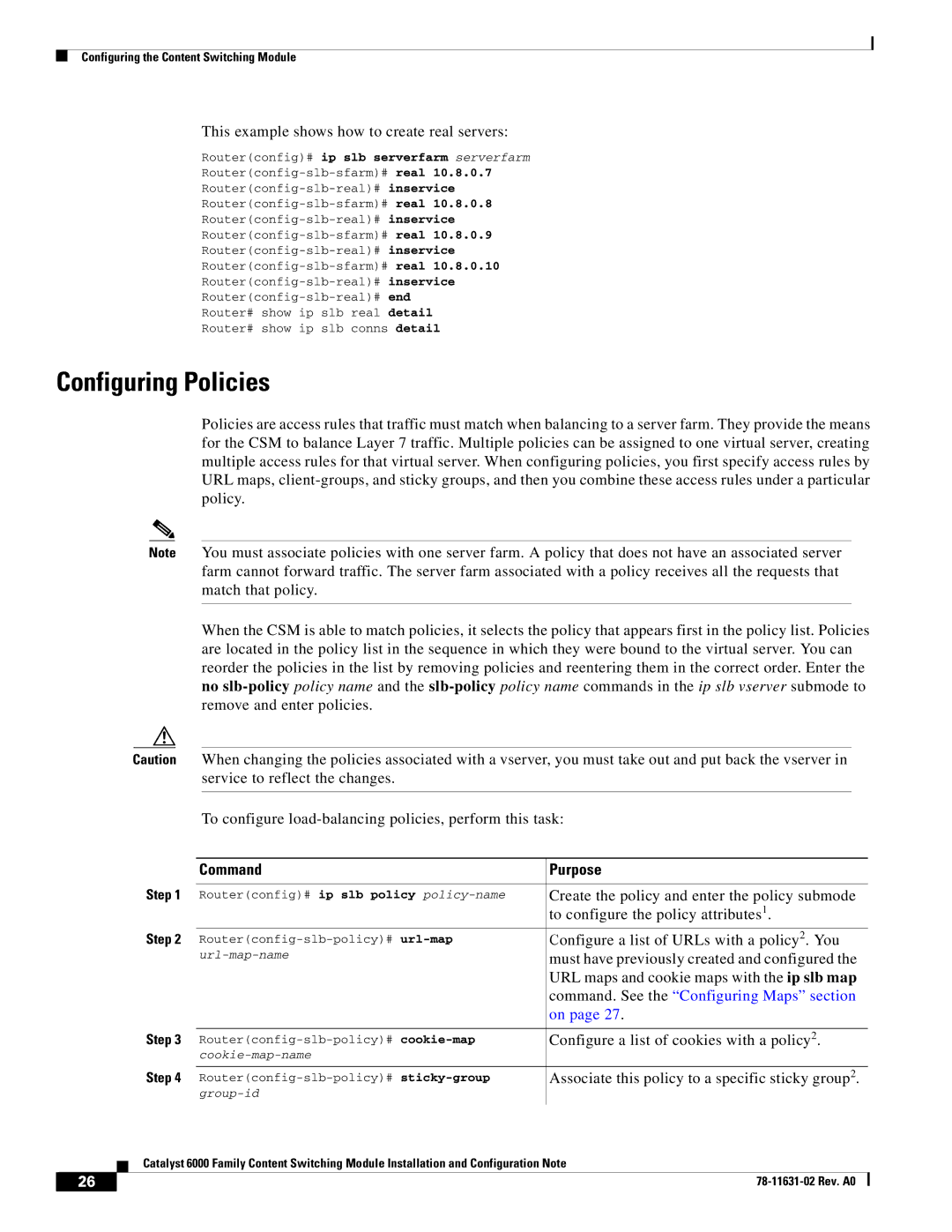
Configuring the Content Switching Module
This example shows how to create real servers:
Router(config)# ip slb serverfarm serverfarm
Router# show ip slb real detail
Router# show ip slb conns detail
Configuring Policies
Policies are access rules that traffic must match when balancing to a server farm. They provide the means for the CSM to balance Layer 7 traffic. Multiple policies can be assigned to one virtual server, creating multiple access rules for that virtual server. When configuring policies, you first specify access rules by URL maps,
|
|
|
| Note |
| You must associate policies with one server farm. A policy that does not have an associated server | |||||
|
|
|
|
|
|
| farm cannot forward traffic. The server farm associated with a policy receives all the requests that | ||||
|
|
|
|
|
|
| match that policy. |
|
|
|
|
|
|
|
|
|
|
|
|
|
|
| |
|
|
|
|
|
|
| When the CSM is able to match policies, it selects the policy that appears first in the policy list. Policies | ||||
|
|
|
|
|
|
| are located in the policy list in the sequence in which they were bound to the virtual server. You can | ||||
|
|
|
|
|
|
| reorder the policies in the list by removing policies and reentering them in the correct order. Enter the | ||||
|
|
|
|
|
|
| no | ||||
|
|
|
|
|
|
| remove and enter policies. |
|
|
|
|
|
|
|
|
|
|
|
|
|
|
| |
|
|
| Caution |
| When changing the policies associated with a vserver, you must take out and put back the vserver in | ||||||
|
|
|
|
|
|
| service to reflect the changes. |
|
|
|
|
|
|
|
|
|
|
|
|
|
|
| |
|
|
|
|
|
|
| To configure | ||||
|
|
|
|
|
|
|
|
| |||
|
|
|
|
|
| Command | Purpose | ||||
|
|
|
| Step 1 |
|
|
| ||||
|
|
|
| Router(config)# ip slb policy | Create the policy and enter the policy submode | ||||||
|
|
|
|
|
|
|
| to configure the policy attributes1. |
| ||
|
|
|
| Step 2 | Configure a list of URLs with a policy2. You | ||||||
|
|
|
|
|
| must have previously created and configured the | |||||
|
|
|
|
|
|
|
| URL maps and cookie maps with the ip slb map | |||
|
|
|
|
|
|
|
| command. See the “Configuring Maps” section | |||
|
|
|
|
|
|
|
| on page 27. | |||
|
|
|
|
|
|
|
| ||||
|
|
|
| Step 3 | Configure a list of cookies with a policy2. | ||||||
|
|
|
|
|
|
|
|
|
| ||
|
|
|
|
|
|
|
| ||||
|
|
|
| Step 4 | Associate this policy to a specific sticky group2. | ||||||
|
|
|
|
|
|
|
|
|
| ||
|
|
|
|
|
|
| |||||
|
|
|
| Catalyst 6000 Family Content Switching Module Installation and Configuration Note | |||||||
|
|
| |||||||||
|
|
|
|
|
|
|
|
|
|
|
|
| 26 |
|
|
|
|
|
|
|
| ||
|
|
|
|
|
|
|
| ||||
